Coffee kombucha has gained a lot of popularity over the past couple of years, yet many coffee lovers still don’t understand what it is. Is it just regular kombucha made with a coffee flavor? Is it the same as fermented coffee? And how do I make my own coffee kombucha? In this piece, we get into those answers and a lot more.
Plus, you’ll learn why drinking kopi luwak is actually even healthier for you than drinking coffee kombucha, especially when you drink a unique strain of kopi luwak like Pure Kopi Luwak.
What is kombucha and where does it come from?
The origin of the word “kombucha” is not entirely clear. Some say that it comes from the Japanese word konbucha or kobucha, which literally means “kelp tea”. Others hold that it most likely comes from the far eastern provinces of China, where it was amply used in the silk and tea trading routes.
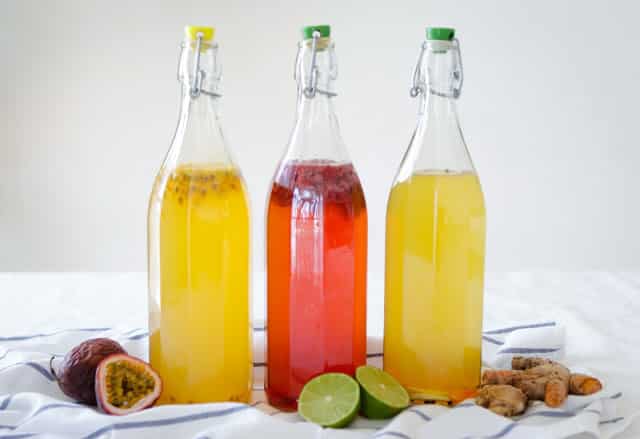
This is the sort of kombucha most people are familiar with – fruity, fizzy and not coffee kombucha.
Regardless of the word’s origin, kombucha is a special, refreshing, slightly acidic beverage produced by the fermentation of sweetened tea. “Regular” kombucha is prepared from both black and green tea alike, and it’s been around for centuries, consumed by people all over the world for its wide range of health benefits.
But we’re here to talk about coffee kombucha, not “regular” kombucha.
What is coffee kombucha?
The world is pretty much divided into coffee drinkers and tea drinkers. Both are always looking for different ways to use, mix and tweak their favorite caffeine source. Kombucha could be thought of as a sort of specialty tea drink, whereas coffee kombucha would be its counterpart for coffee drinkers. As you may imagine, coffee kombucha is a variation of regular kombucha in which, rather than fermenting black tea or green tea, you ferment brewed coffee.
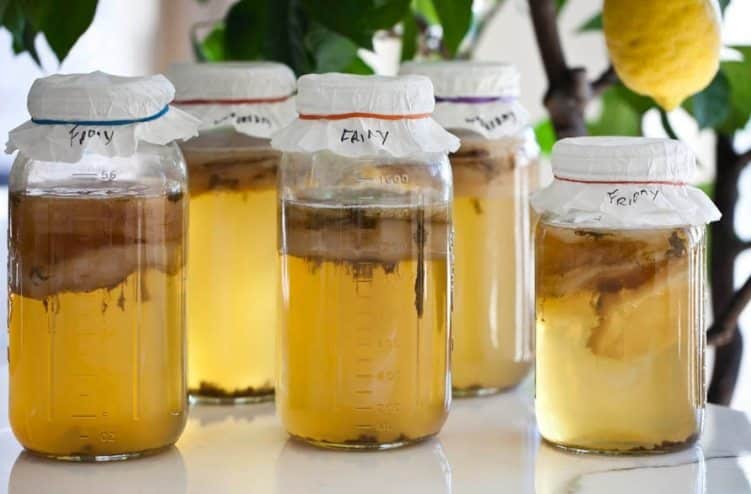
Coffee kombucha looks very different from other types of kombucha.
Fermentation is the process in which small microorganisms, like bacteria, fungi or yeasts, break down large molecules present in foods into smaller compounds they can use for energy and growth. In the case of any kombucha, fermentation is achieved by a special kind of bacteria called acetic bacteria and certain types of yeast, which eat the sugar in the sweetened solution and produce acid compounds like acetic acid (the same acid present in vinegar), and gases like carbon dioxide (the same gas present in sodas and other carbonated drinks).
The fermenting microorganisms are introduced into the solution in the form of a semi-solid, gelatinous-looking disc called a SCOBY. SCOBY stands for Symbiotic Colony Of Bacteria and Yeasts and it is, as its name suggests, a colony of different types of microorganisms—yeasts and bacteria are different types of microorganisms—living together in harmony in such a way that they help fulfill each other’s necessities. That’s why it’s called symbiotic.
You can think of a SCOBY as a small, isolated city in which there are different individuals who perform different tasks, with each task necessary for the survival of the city. In SCOBYs, yeasts eat sugars and break them down into alcohols, and then the bacteria eat the alcohols produced by the yeasts and turn them into organic acids like acetic acid. There are also a lot of other byproducts to the fermentation process that add different tastes and flavors to fermented foods and beverages.
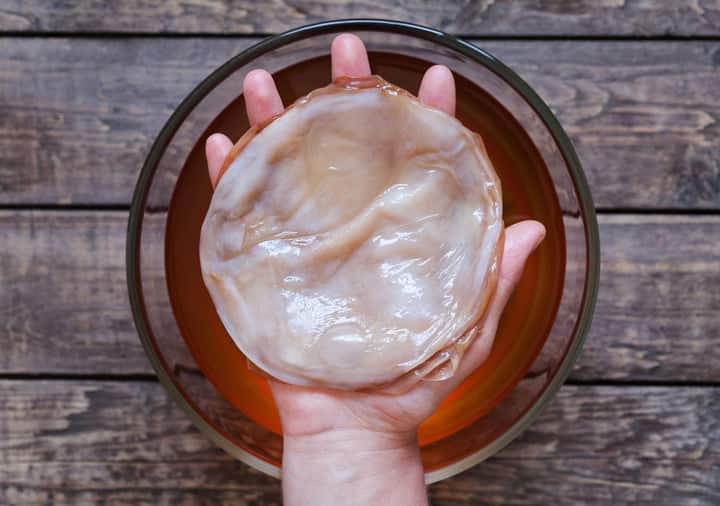
Don’t be scared – this is what every SCOBY looks like.
Is it coffee kombucha, or kombucha coffee?
If you surf around the web you’ll see that some people talk about coffee kombucha, and others of kombucha coffee. Both are actually talking about the same thing. Which one is correct? Well, that depends on your point of view. If you’re a tea lover, you’d probably say it should be called coffee kombucha, given that it’s a variation of tea kombucha, but with coffee. “The important fact is that it’s a kombucha, not that it’s made with coffee,” he or she would say. A coffee drinker, on the other hand, would probably say it should be called kombucha coffee, and argue that it’s actually brewed coffee that has been modified by the fermentation process.
Call it what you may, it’s a very special drink with a unique and distinctive flavor—some say an acquired taste—and health benefits that will turn even the most reluctant person into a fan.
Looking for a healthy alternative to regular coffee? Try 100% organic Pure kopi luwak today.
How is coffee kombucha made?
As mentioned before, coffee kombucha is made by introducing a SCOBY into a sweetened coffee solution and then allowing it to ferment. That sounds easy enough, and it really is, though there are a few things you’ll want to take into account:
- A SCOBY is a live colony of microorganisms, so if it is heated too much, the bacteria end yeasts will die and the SCOBY will be rendered useless.
- If you are an experienced kombucha brewer, you might think that making coffee kombucha follows the same process as regular tea kombucha, but there are a few key differences. The most important difference is that coffee is naturally more acidic than tea, so making coffee kombucha doesn’t require adding vinegar to the mix. Second, for better taste and an extra sparkling kick, coffee kombucha is fermented twice, instead of once like regular kombucha.
What do I need to make coffee kombucha?
Makes 3 quarts (12 cups)
What You Need
Ingredients:
- Enough ground coffee for brewing 3 quarts of coffee
- 1 cup white, brown or cane sugar
- ¼ cup of sugar syrup (prepared dissolving ¼ cup of sugar into ¼ cup of hot water)
- 1 kombucha SCOBY
- 1 tbsp raw (unpasteurized) regular kombucha
Equipment
- Coffee machine, AeroPress or other method of brewing coffee
- A large glass jar with 3+ quarts of capacity for the first fermentation
- Smaller, air-tight Mason jars or bottles for the second fermentation
- Tightly-knit cheesecloth or a coffee filter big enough to cover the glass jar’s lid
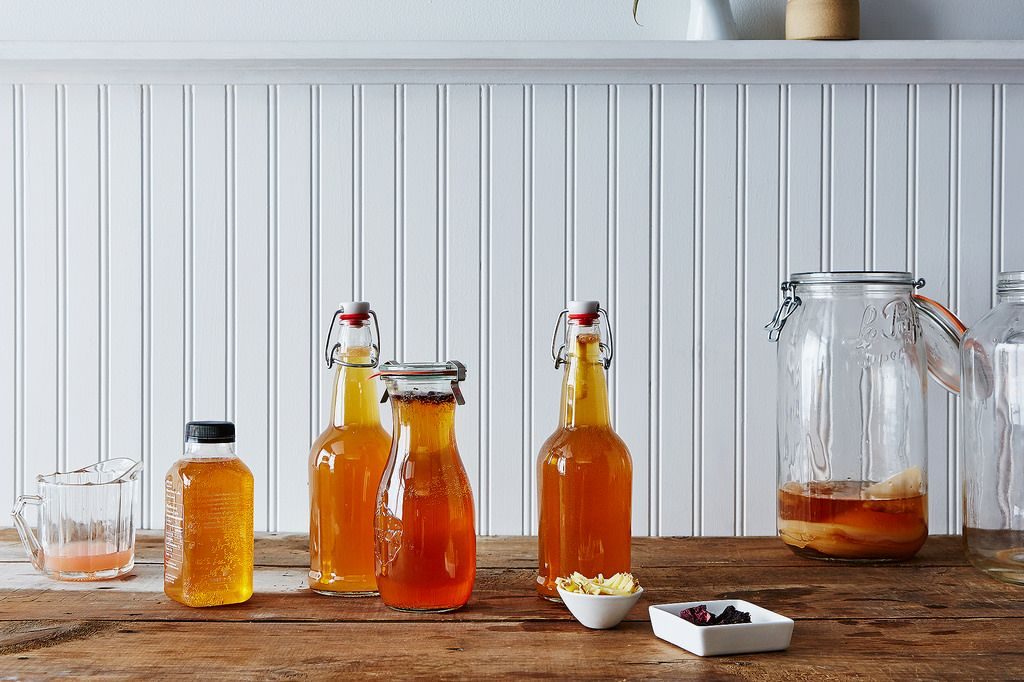
You’ll want at least one big jar for the first fermentation of your coffee kombucha, plus several smaller jars for the second fermentation.
Instructions
Step 1: Prepare The Coffee
Brew 3 quarts of coffee using your method of choice, and add 1 cup of sugar while the coffee is still hot. Let it cool to room temperature and pour it in the glass jar.
Step 2: The First Fermentation
Add the SCOBY and 1 tbsp of kombucha to the jar, and then cover it with the cheesecloth or coffee filter, holding it in place with a rubber band or a string. Let sit at room temperature for 3 to 6 days to allow the fermentation to occur. On the third day, taste it to see how it’s progressing. The flavor is difficult to describe, though you should notice a tangy, slightly acidic and bitter taste. You’ll probably notice that the SCOBY looks different—it might be a little bit bigger. This is normal.
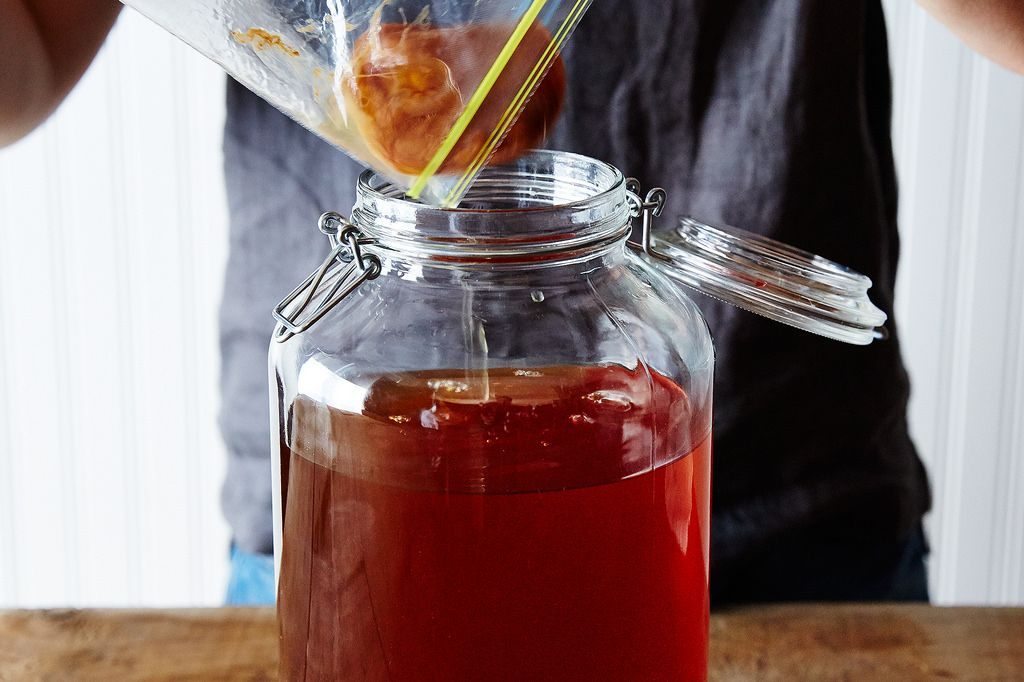
Once your coffee is made, add your SCOBY to get the fermentation process started.
Step 3: The Second Fermentation
Carefully remove the SCOBY so that it comes out in one piece. If it crumbles while you’re removing it, that’s fine—just remove all the pieces or filter your fermented coffee into another glass jar or container. Add the ¼ cup sugar syrup, mix it together and pour the mixture into your Mason jars or air-tight bottles. Seal the jars and let it sit for another 24-48 hours at room temperature.
Step 4: Store
After the second fermentation is done, your coffee kombucha is ready to go. Keep it in the refrigerator from now until you’ve finished it to avoid further fermentation
Pro Tips:
- If your coffee kombucha comes out too bitter, you can sweeten it right before the second fermentation with stevia. The sugar syrup itself won’t do the trick because the bacteria and yeasts eat the sugar during fermentation, whereas stevia sweeteners contain a family of compounds called steviol glycosides which taste sweet but aren’t eaten or degraded by the SCOBY microorganisms. That’s why they’re able to survive the fermentation and sweeten the final kombucha, while regular sugar cannot.
- If you want to tweak the flavor a bit, you can also add vanilla extract or other natural flavors before the final fermentation.
Health benefits of coffee kombucha
Coffee kombucha provides all the basic health benefits of all cultured foods plus much, much more, even compared with regular kombucha. Among the main benefits you’ll get from drinking coffee kombucha are:
#1 Packed With Probiotics
Coffee kombucha is full of probiotics, the good microorganisms that stay in your body and help you out in different ways. The main health benefits of probiotics can be found in this excellent review article, and they include:
- Probiotics improved intestinal health, since they help break down molecules in food into smaller compounds that are easier for the body to digest and absorb.
- Probiotics help reduce or treat antibiotic-induced diarrhea and other types of diarrhea as well.
- Probiotics enhance the immune response, helping your body fight off and prevent diseases caused by harmful bacteria and other pathogens.
- Probiotics reduce cholesterol in the blood.
- Probiotics help to prevent cancer.
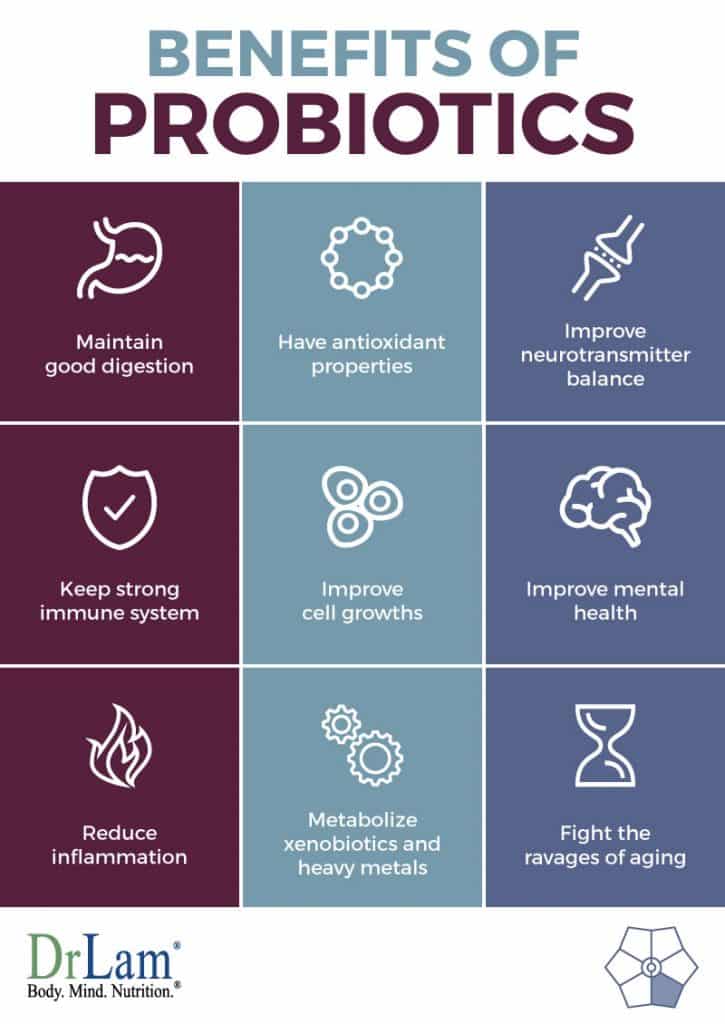
Coffee kombucha is packed with probiotics, which have dozens of health benefits of their own.
#2 Lower Fluoride Concentration
When compared to regular kombucha, coffee kombucha has a lower fluoride concentration. While more research needs to be done into how fluoride affects the body, the current body of knowledge suggests that fluoride is associated with diabetes and cancer. Fluoride is known to cross the blood-brain barrier, one of the body’s main protective devices, and can pass through the placenta into the body of an unborn baby.
#3 Much Less Caffeine
Coffee kombucha is essentially decaffeinated, so it can be drank by coffee lovers who can’t stand caffeine at any time of the day. We’ll explain why there’s so much less caffeine in coffee kombucha below.
Add all of these health benefits to the benefits of regular coffee, like the high amount of antioxidants, reduced blood pressure and boost in energy and you’ll see why coffee kombucha is quickly becoming such a trendy beverage.
If you want to get even more out of your coffee kombucha, try brewing a jar with kopi luwak (aka civet coffee or cat poop coffee), which in itself has even more health benefits than regular coffee.
Why is kopi luwak even healthier than coffee kombucha?
Coffee kombucha clearly has some important health benefits, but kopi luwak has even more that coffee kombucha doesn’t offer. Here are three of the main health benefits of kopi luwak.
Kopi Luwak Benefit #1: Malic Acid
Malic acid is an organic compound made naturally by all living organisms. It is known for its ability to rapidly increase energy and tolerance to strenuous exercise and muscle pain, which is why it’s often given as a supplement for chronic fatigue syndrome.
According to the Journal of Nutritional Medicine, malic acid aids in the Krebs cycle, our body’s process of metabolizing fats, carbohydrates and proteins into usable energy in the body. The Journal of Rheumatology agrees: exogenous malic acid (malic acid ingested from outside the body, such as through kopi luwak) helps the body to make ATP, the body’s energy, more efficiently.
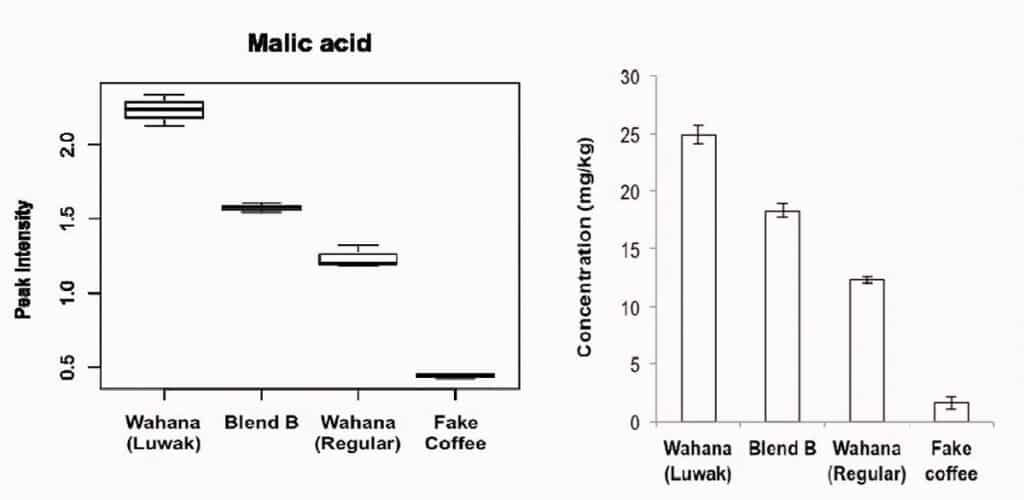
Pure kopi luwak has more malic acid than any other type of coffee tested
As you can see in this chart (taken from the study mentioned above), there are significantly higher levels of malic acid in kopi luwak than in other types of coffee. (Note: kopi luwak is shown on the far left of the chart, with a blend of kopi luwak and regular beans next to that, then just regular beans, and finally fake coffee on the far right.) Experts believe this is why kopi luwak gives a smoother, longer-lasting boost of energy than other coffees.
Kopi Luwak Benefit #2: Citric Acid
Citric acid is an organic compound that occurs naturally in the human body (in small quantities) and in citrus fruits like lemons and limes (in larger quantities). Just like malic acid, it also plays a major role in the Krebs cycle, which means boosted levels of citric acid give you more energy.
When citric acid is metabolized by the body, it actually increases the body’s pH levels, making it more alkaline. That’s exactly why many people on an alkaline diet—a diet adamantly supported by people like Tony Robbins—add lemon to their water in the mornings; contrary to what you may think, adding citric acid to your diet makes your body more alkaline, and thus stronger and more capable overall.
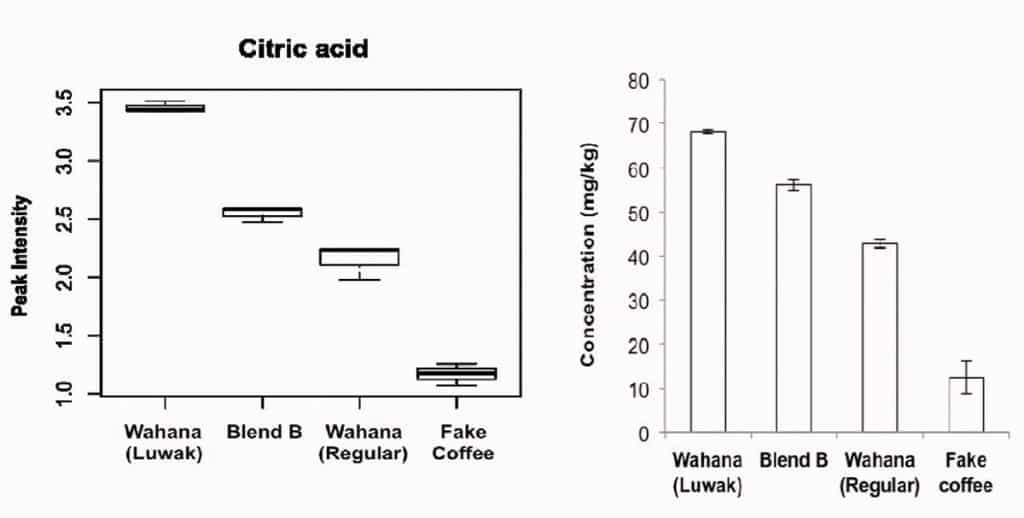
Pure kopi luwak is packed with uber-healthy citric acid
This chart shows that kopi luwak clearly has much more citric acid than any of the other coffee types tested. Here are three more benefits of citric acid:
- Combats the development of kidney stones
- Defends against osteoporosis by strengthening bones
- Increases iron absorption
Kopi Luwak Benefit #3: Inositol
Inositol is a natural sugar alcohol made naturally in our kidneys and found in plenty of other foods. Inositol is essential in building cell membranes and acts as a “secondary messenger” in your nervous system, which means it increases the impact of neurotransmitters in your brain. That’s a really good thing.
Many women are familiar with inositol because of all the research that’s been done into its effects on treating polycystic ovarian syndrome (PCOS). PCOS affects between 5-20% of women and, as this review of twelve studies explains, “PCOS is the most common cause of anovulatory infertility in industrialized nations, and it is associated with insulin resistance, type 2 diabetes mellitus, and increased cardiovascular risk.” In other words, you want to take any steps you can to reduce your chances of PCOS. Fortunately, the same study review goes on to explain that inositol “is capable of restoring spontaneous ovulation and improving fertility in women with PCOS.”
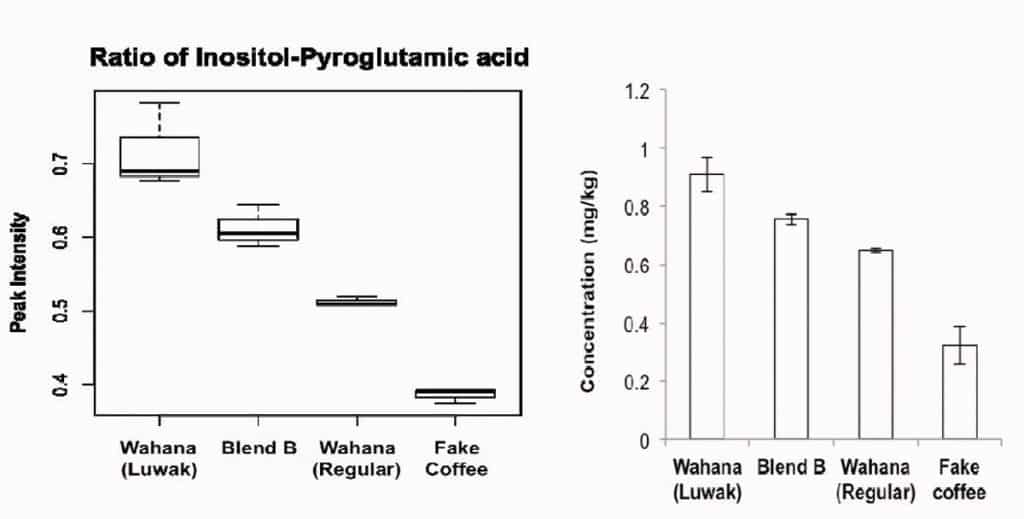
Pure kopi luwak is full of inositol, which helps the body in numerous ways
These are only the beginning of the benefits of inositol—it’s been shown to combat depression, anxiety and obsessive compulsive disorder, too. The chart above shows the ratio of inositol to pyroglutamic acid in kopi luwak, though to keep things simple, just think of it as the amount of inositol in the coffee. Again, kopi luwak comes out ahead of every other type of coffee by a long shot, meaning you get a much bigger boost of these benefits when you drink kopi luwak than you do with other coffees.
Kopi luwak has significantly more malic acid, citric acid and inositol than any of the other coffee types tested, research shows. With all of this talk about acid, you might think that kopi luwak would be quite a bitter-tasting coffee, though in reality, that’s not even remotely true. As this study shows, there is no correlation between the pH of coffee (its scientifically-measured acidity level) and how acidic it tastes in the human mouth. In fact, the coffee brew that tasted the most acidic of the nine types observed in that study was actually the least acidic (it had the highest pH value) of them all.
On top of all that, coffee experts praise kopi luwak’s natural fermentation process, which occurs inside the civet, because it yields a coffee that tastes much smoother and less acidic than other types of coffee.
This is only the beginning of the health benefits of kopi luwak, though we don’t have space to mention all of them here. Still, the basic principle of kopi luwak is simple: while maintaining all of the health benefits of other types of coffee, it has a whole host of its own, making kopi luwak one of the healthiest coffees in the world.
So if health is your primary concern, drinking coffee kombucha made with kopi luwak — or just kopi luwak on its own — will get you the health benefits you’re looking for.
And there’s no better kopi luwak out there than Pure Kopi Luwak, the healthiest kopi luwak on the market today. Try yours today to receive free shipping within the USA (for a limited time).
Is coffee kombucha the same as fermented coffee?
Coffee kombucha is indeed coffee that has been fermented, but when you go to the store and the grocer offers you fermented coffee, that’s not coffee kombucha. The term “fermented coffee” is used to refer to ground or roasted coffee that has been fermented before the roast, normally either in the green coffee or parchment coffee stages of coffee production. Coffee kombucha, on the other hand, refers to coffee that has been fermented after brewing.
Another key difference is that while nearly all of the probiotics present after the fermentation process in “fermented coffee” are killed during the roast—leaving only the beneficial compounds derived from the fermentation itself—coffee kombucha maintains all of the healthy probiotics. That means your coffee kombucha is ready to give you that extra health boost common among all cultured foods.
How does coffee kombucha taste?
Many say that kombucha of all types is an acquired taste, since fermentation produces acetic acid as a byproduct. Some people even describe regular kombucha as apple cider vinegar gone bad. However, most people don’t like kombucha because they’re not yet accustomed to the taste, regardless of its health benefits. Coffee kombucha, on the other hand, has the added bonus of adding that roasted flavor to the mix, and since coffee is already naturally acidic, for all of us coffee lovers, the extra acidity derived from the fermentation is nothing new.
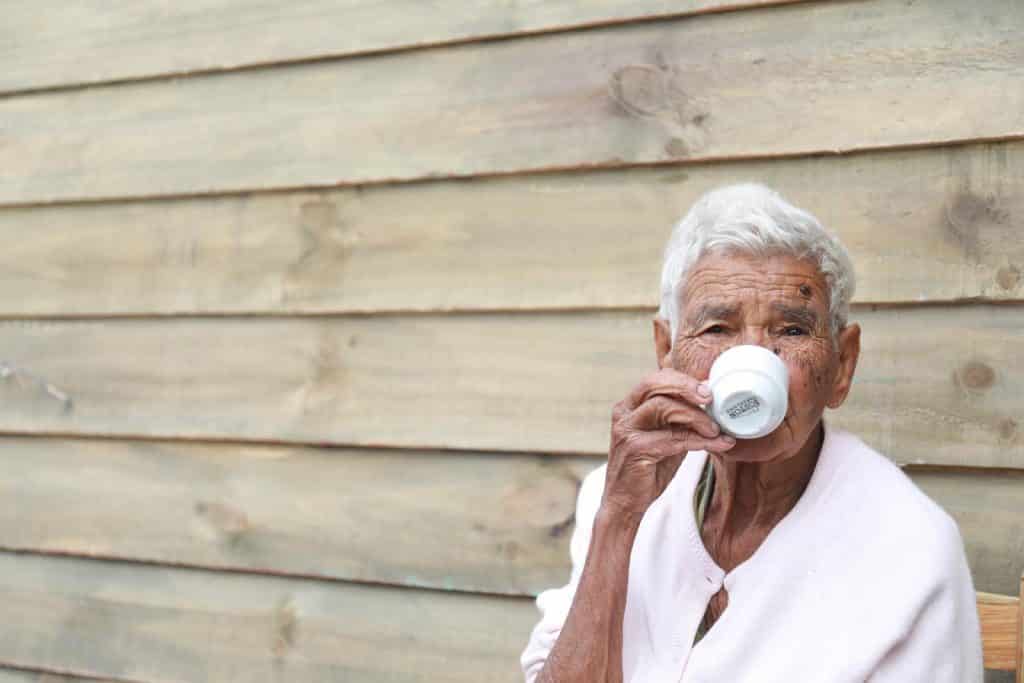
Just about everyone can appreciate the taste of coffee kombucha.
How much caffeine is in coffee kombucha?
The SCOBY microorganisms break down many of the organic compounds in the sweetened coffee solution, including caffeine. This means that fermentation naturally decaffeinates coffee, and therefore coffee kombucha comes out with very little caffeine left.
There is very little research on the caffeine content of coffee kombucha, but there are some reported studies con regular kombucha that we can look to for guidance.
Black tea has higher caffeine content than coffee. When you brew regular kombucha made of black tea, the resulting drink has a caffeine content of approximately 8-14mg of caffeine per 8oz serving. Since coffee has less caffeine to start with, it is logical to think that coffee kombucha has even less caffeine than that. To give you a better idea, it has been reported here that a Starbucks decaf espresso has about 6-7mg of caffeine per 8oz serving (yes, believe it or not, decaffeinated coffee still has caffeine in it), so you can expect that your batch of coffee kombucha will have even less caffeine than your average decaf coffee.
What’s the best type of coffee to use for coffee kombucha?
It’s best to make coffee kombucha with a low-caffeine coffee strain for two main reasons:
- High-caffeine coffees will cause your coffee kombucha to be extra bitter and acidic, which most people don’t like the taste of.
- If you enjoy drinking coffee kombucha in the evening, using low-caffeine coffee means it won’t keep you up all night.
That’s why we recommend making your coffee kombucha with kopi luwak, a low-caffeine alternative with a sparkling, refreshing taste as coffee kombucha that you can drink at any time of day.
Does coffee kombucha have any alcohol content?
Yes it does, but very little. The yeasts in the SCOBY (usually a particular type of yeast called Saccharomyces) ferment sugars and turn them into ethanol (ethanol is the chemical name of the alcohol present in alcoholic beverages). A large part of that produced ethanol is used by the other bacteria present in the SCOBY and oxidized (transformed) into acetic acid (the acid found in vinegar). So in the end, the only ethanol still present in the kombucha is what was left behind by the bacteria.
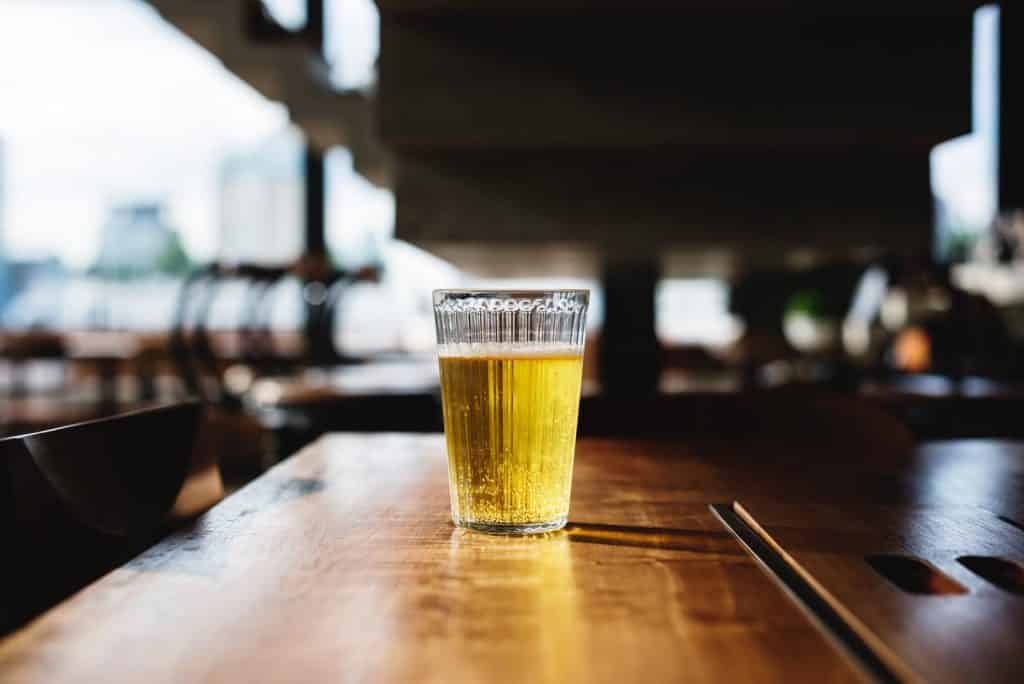
If you’ve been wondering whether coffee kombucha has alcohol content, the answer is yes, a very small amount.
This study shows that the alcohol content of kombucha increases during the first days of fermentation, and reaches a peak at around 10 days. At its highest, the alcohol content of kombucha is only 0.5%, about one-tenth of that of a regular beer. There are some brands of regular kombucha that are intentionally fermented in a way as to produce higher alcohol content, but those are sold in the liquor sections of stores and supermarkets.
“The French paradox” even demonstrates that drinking very small amounts of alcohol daily yields reduced risk of coronary heart disease, even if you eat lots of saturated fat and cholesterol (a lot of bacon). This means that the alcohol content in coffee kombucha could actually be seen as a benefit: if you drink it daily, you’ll face lower risk of a heart attack.
How long does coffee kombucha last?
There are no reported studies available on the shelf life of coffee kombucha, so more research needs to be done. It is a live beverage, though, so we highly recommend that after you perform your second fermentation, you store your coffee kombucha in the refrigerator to stop any further fermentation. This actually doesn’t stop the fermenting completely—it only slows it down—so after about a week it’s possible that your kombucha could become over-fermented. The natural oils in coffee, when fermented, tend to turn into sour-tasting organic acids, so it’s better to not let your coffee kombucha sit for more than 7-10 days.

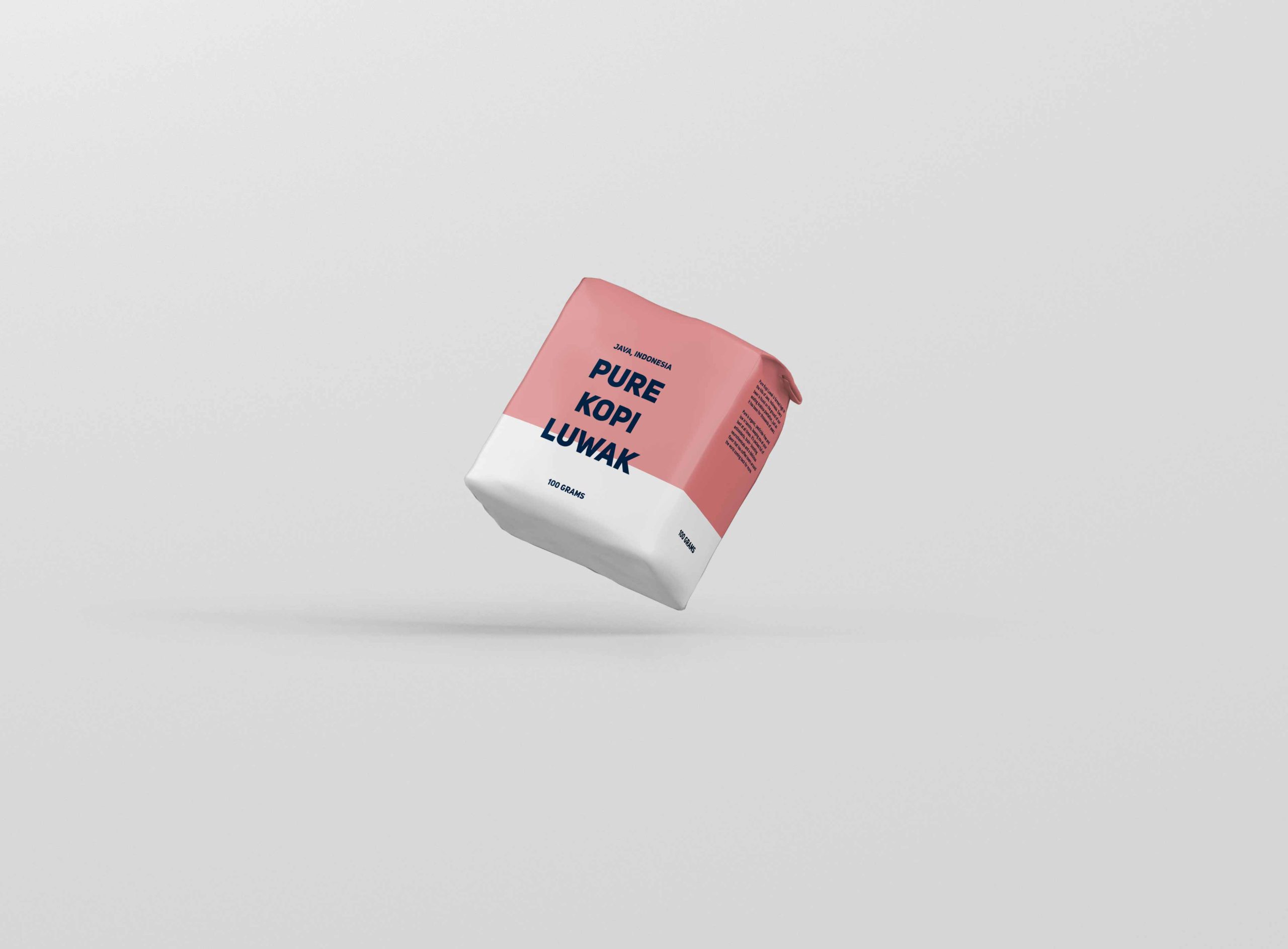
Liz
fun article. I love making koffucha. I drink it with a dollop of heavy cream. it’s wonderful. I was wondering if you know of any actual studies done on coffee kombucha not just kombucha? I wasn’t able to locate any. Since the SCOBY doesn’t grow when you make coffee kombucha I’m a little wary on claiming all the same health benefits as kombucha tea. I do always get a new SCOBY however it’s just a thin film not a healthy opaque SCOBY.
admin
Hi Liz,
Glad to hear you enjoy koffucha as much as we do! The heavy cream is a nice touch 🙂 There really isn’t much scientific literature around coffee kombucha, unfortunately, since it’s still in the early stages of its life cycle. We’ll definitely be keeping an eye out for studies, though, and we’ll be posting more on our blog when that changes. Until then, let us know if you’d like to try some of our kopi luwak. Thanks, Liz!
Pure
Michael
Mine grow very healthy, thick SCOBYs just like my tea kombucha! I’m surprised to hear yours do not- I would say that’s not the norm. I’m just using coffee, regular ol’ granulated sugar, and filtered water. I do need a recipe for the coffee flavored vinegar when I overferment….
Mack R
I make a cold brew coffee in the refrigerator. Can I make a kombucha by just adding a scoby without removing the grounds. Speaking of grounds, is there a preferred grind? I use a coarse grind.
Chris Boyle
I just tried this for the first time. I took a cold brew concentrate that was at 4.93 tds. Then dissolved the sugar in some water. Combined those two with some tea based starter liquid and some SCOBY. It was moving a little slow so I added a heat jacket and it turned out pretty good. I fermented it for 10 days. I may cut some of it with plain kombucha because it does taste pretty strong. I will use less cold brew next time.